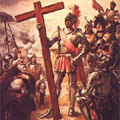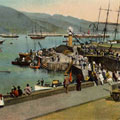History.
 Those who are responsible for researching into peoples’ historic roots find it pleasurable to say that since the earliest legendary or historic narrations about the Canaries, Tenerife is mostly mentioned. This is because the view of a huge snow-capped mountain, that could be spotted from various kilometers around and emerging above the highest clouds, must have clearly impressed those ancient sailors.
Those who are responsible for researching into peoples’ historic roots find it pleasurable to say that since the earliest legendary or historic narrations about the Canaries, Tenerife is mostly mentioned. This is because the view of a huge snow-capped mountain, that could be spotted from various kilometers around and emerging above the highest clouds, must have clearly impressed those ancient sailors.
Until it was conquered by the Europeans, a situation that lasted for almost all of the 15 th century, this island was probably inhabited by a population of a North African origin, plunged in the Paleolithic period, though with certain signs of a slightly superior culture in terms of religion and craftsmanship.
Tenerife ’s pre-Hispanic moderating “guanches” wore coarse furs and it all leads one to believe that they did not know the art of navigation. However, they mummified the dead using very efficient techniques and there is evidence that they had a special taste for decoration items.
Some people have written that ancient writers, and even some modern ones, have said that the Canary Isles were the visible and highest remains of a sunken continent: Atlantis, while “the guanches” were the descendants of the Atlanteans, the sons and grandsons of the mountain inhabitants of that legendary world, who suddenly became islanders after the hecatomb much to their regret. Likewise, it has been said that when Spanish colonizers arrived in Tenerife, the island was divided into nine small kingdoms or “menceyatos” and each one was led by a monarch or “mencey”, who took advice from an elders’ assembly.
 Emphasis should be laid on the fact that the archipelago’s conquest had begun in 1402, when Jean de Bethencourt and Gadifier de la Salle made their first trips to Lanzarote, Fuerteventura and El Hierro, on behalf of Henry III. Those lands were easily annexed to Castile, while Fernán Peraza did the same thing with La Gomera.
Emphasis should be laid on the fact that the archipelago’s conquest had begun in 1402, when Jean de Bethencourt and Gadifier de la Salle made their first trips to Lanzarote, Fuerteventura and El Hierro, on behalf of Henry III. Those lands were easily annexed to Castile, while Fernán Peraza did the same thing with La Gomera.
Tenerife was precisely the last island to be conquered, an event that was possible after bloody wars where the Spaniards, led by captain-general Alonso Fernández de Lugo, suffered a few odd spectacular defeats as was the case of La Matanza (The Slaughter) in 1494.
Canaries show their link to the Americas in a very interesting way, as they have served as an unavoidable springboard for the ships headed for that continent.
This archipelago was also a permanent target for pirates and foreign powers. History says that in 1787 admiral Nelson attempted to take over Santa Cruz de Tenerife with his ships, but he was defeated in a risky operation by general Gutiérrez’s troops.
The Canary Isles, due to their geographical position, have maintained certain economic and administrative peculiarities in relation to the rest of the national territory. This is shown in some legislation adopted, as is the case of the so-called free-port act from the late 19 th century (1872), the creation of the Island Councils, which come to be a sort of island governments (1912) and the implementation of the Economic and Tax System Act especially made for the archipelago.
Let us not forget that as of 1982, Canaries became an Autonomous Community and in 1986 it joined the European Economic Community, together with the rest of the Spanish State, through a different model.